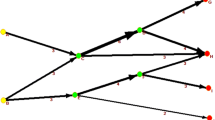Abstract
To survive worldwide competitions of research and development in the current rapid increase of information, decision-makers and researchers need to be supported to find promising research fields and papers. But finding those fields from an available data in too much heavy flood of information becomes difficult. We aim to develop a methodology supporting to find emerging leading papers with a bibliometric approach. The analyses in this work are about four academic domains using our time transition analysis. In the time transition analysis, after citation networks are constructed, centralities of each paper are calculated and their changes are tracked. Then, the centralities are plotted, and the features of the leading papers are extracted. Based on the features, we proposed ways to detect the leading papers by focusing on in-degree centrality and its transition. This work will contribute to finding the leading paper, and it is useful for decision-makers and researchers to decide the worthy research topic to invest their resources.








Similar content being viewed by others
References
Adams, J. (2005). Early citation counts correlate with accumulated impact. Scientometrics, 63(3), 567–581.
Börner, K., Chen, C. & Boyack, K.W. (2003). Visualizing knowledge domains. In Annual review of information Science and technology (pp. 179–255).
Carpineto, C., de Mori, R., Romano, G., & Bigi, B. (2001). An information-theoretic approach to automatic query expansion. ACM Transactions on Information Systems, 19(1), 1–27.
Chen, C., Chen, Y., Horowitz, M., Hou, H., Liu, Z., & Pellegrino, D. (2009). Towards an explanatory and computational theory of scientific discovery. Journal of Informetrics, 3, 191–209.
Chen, S. H., Huang, M. H., & Chen, D. Z. (2012). Identifying and visualizing technology evolution: A case study of smart grid technology. Technological Forecasting and Social Change, 79, 1099–1110.
Ehrenberg, M. (2008). The green fluorescent protein: discovery, expression and development. Retrieved November 16, 2012 from http://www.nobelprize.org/nobel_prizes/chemistry/laureates/2008/advanced-chemistryprize2008.pdf.
Garfield, E. (1955). Citation indexes for science: A new dimension in documentation through association of ideas. Science, 122(3159), 108–111.
Garfield, E., & Welljams-Dorof, A. (1992). Of Nobel class: A citation perspective on high impact research authors. Theoretical Medicine, 13, 117–135.
Gingras, Y., & Wallace, M. L. (2010). Why it has become more difficult to predict Nobel Prize winners: a bibliometric analysis of nominees and winners of the chemistry and physics prizes (1901–2007). Scientometrics, 82, 401–412.
Leydesdorff, L. (2004). Clusters and maps of science journals based on bi-connected graphs. Journal of Documentation, 60(4), 371–427.
Leydesdorff, L. (2012). Statistics for the dynamic analysis of scientometric data: The evolution of the sciences in terms of trajectories and regimes. Scientometrics, 96, 731–741.
Leydesdorff, L., & Rafols, I. (2009). A global map of science based on the ISI subject categories. Journal of the American Society for Information Science and Technology, 60(2), 348–362.
Liu, X., Jiang, T., & Ma, F. (2013). Collective dynamics in knowledge networks: Emerging trends analysis. Journal of Infometrics, 7, 425–438.
Manh Cuong, P., Derntl, M., & Klamma, R. (2012). Development patterns of scientific communities in technology enhanced learning. Journal of Educational Technology & Society, 15, 323–335.
Nakamura, H., Suzuki, S., Tomobe, H., Kajikawa, Y., & Sakata, I. (2011). Citation lag analysis in supply chain research. Scientometrics, 87(2), 221–232.
NetworkX developer Team (2013). NetworkX. Retreived January 1, 2013, from http://networkx.github.com/.
Shibata, N., Kajikawa, Y., Takeda, Y., & Matsushima, K. (2008). Detecting emerging research fronts based on topological measures in citation networks of scientific publications. Technovation, 28(11), 758–775.
Shibata, N., Kajikawa, Y., Takeda, Y., & Matsushima, K. (2009). Comparative study on methods of detecting research fronts using different types of citation. Journal of the Association for Information Science and Technology, 60, 571–580.
Shibata, N., Kajikawa, Y., Takeda, Y., Sakata, I., & Matsushima, K. (2011). Detecting emerging research fronts in regenerative medicine by the citation network analysis of scientific publications. Technological Forecasting and Social Change, 78, 274–282.
Small, H. (2006). Tracking and predicting growth areas in science. Scientometrics, 68, 595–610.
The Royal Swedish Academy of Sciences. (2011). The Nobel Prize in Chemistry 2011—Information for the public: Crystals of golden proportions. Retrieved August 31, 2013, from http://www.nobelprize.org/nobel_prizes/chemistry/laureates/2011/popular-chemistryprize2011.pdf.
Tu, Y., & Seng, J. (2012). Indices of novelty for emerging topic detection. Information Processing and Management, 48, 303–325.
Vanclay, J. K. (2011). Impact factor: outdated artefact or stepping-stone to journal certification? Scientometrics, 92(2), 211–238.
Xu, J., & Croft, W. B. (2000). Improving the effectiveness of information retrieval with local context analysis. ACM Transactions on Information Systems, 18(1), 79–112.
Author information
Authors and Affiliations
Corresponding author
Rights and permissions
About this article
Cite this article
Iwami, S., Mori, J., Sakata, I. et al. Detection method of emerging leading papers using time transition. Scientometrics 101, 1515–1533 (2014). https://doi.org/10.1007/s11192-014-1380-x
Received:
Published:
Issue Date:
DOI: https://doi.org/10.1007/s11192-014-1380-x




